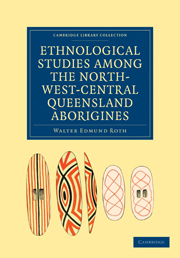Book contents
- Frontmatter
- PREFACE
- BIBLIOGRAPHY
- Contents
- ILLUSTRATIONS
- CHAPTER I THE SPOKEN LANGUAGE OF THE PITTA-PITTA ABORIGINALS: AN ELEMENTARY GRAMMAR
- CHAPTER II TABULAR COMPARISON BETWEEN VARIOUS SELECTED WORDS USED IN THE DIFFERENT ETHNOGRAPHICAL DISTRICTS OF NORTH-WEST-CENTRAL QUEENSLAND
- CHAPTER III SOCIAL AND INDIVIDUAL NOMENCLATURE: CLASS SYSTEMS, &c
- CHAPTER IV THE EXPRESSION OF IDEAS BY MANUAL SIGNS: A SIGN LANGUAGE
- CHAPTER V THE SEARCH FOR FOOD. PITURI
- CHAPTER VI DOMESTIC IMPLEMENTS AND UTENSILS. FIRE-STICKS AND YAM-STICKS. HUTS AND SHELTERS
- CHAPTER VII PERSONAL ORNAMENTATION AND DECORATION. MURAL PAINTING, &C.
- CHAPTER VIII RECREATION: CORROBBOREES, SPORTS, AND GAMES
- CHAPTER IX TRAVEL, TRADE, AND BARTER. THE SO-CALLED LETTER OR MESSAGE-STICK
- CHAPTER X THE MAINTENANCE OF LAW AND ORDER: FIGHTING, FIGHTING WEAPONS
- CHAPTER XI DISEASE, ACCIDENT, DEATH. CANNIBALISM
- CHAPTER XII RAIN-MAKING, THUNDER AND LIGHTNING-MAKING
- CHAPTER XIII ETHNO-PORNOGRAPHY
- INDEX AND GLOSSARY
- Plate section
CHAPTER VII - PERSONAL ORNAMENTATION AND DECORATION. MURAL PAINTING, &C.
Published online by Cambridge University Press: 29 August 2010
- Frontmatter
- PREFACE
- BIBLIOGRAPHY
- Contents
- ILLUSTRATIONS
- CHAPTER I THE SPOKEN LANGUAGE OF THE PITTA-PITTA ABORIGINALS: AN ELEMENTARY GRAMMAR
- CHAPTER II TABULAR COMPARISON BETWEEN VARIOUS SELECTED WORDS USED IN THE DIFFERENT ETHNOGRAPHICAL DISTRICTS OF NORTH-WEST-CENTRAL QUEENSLAND
- CHAPTER III SOCIAL AND INDIVIDUAL NOMENCLATURE: CLASS SYSTEMS, &c
- CHAPTER IV THE EXPRESSION OF IDEAS BY MANUAL SIGNS: A SIGN LANGUAGE
- CHAPTER V THE SEARCH FOR FOOD. PITURI
- CHAPTER VI DOMESTIC IMPLEMENTS AND UTENSILS. FIRE-STICKS AND YAM-STICKS. HUTS AND SHELTERS
- CHAPTER VII PERSONAL ORNAMENTATION AND DECORATION. MURAL PAINTING, &C.
- CHAPTER VIII RECREATION: CORROBBOREES, SPORTS, AND GAMES
- CHAPTER IX TRAVEL, TRADE, AND BARTER. THE SO-CALLED LETTER OR MESSAGE-STICK
- CHAPTER X THE MAINTENANCE OF LAW AND ORDER: FIGHTING, FIGHTING WEAPONS
- CHAPTER XI DISEASE, ACCIDENT, DEATH. CANNIBALISM
- CHAPTER XII RAIN-MAKING, THUNDER AND LIGHTNING-MAKING
- CHAPTER XIII ETHNO-PORNOGRAPHY
- INDEX AND GLOSSARY
- Plate section
Summary
162. Method of Working-up the Hair.—The hair of the head—and especially is this the case with the males—is dressed with grease after growing a certain length, and put up very much after the style of the throms in a mop-broom. This facilitates not only its removal when required for subsequent use in making hairtwine, but also prevents its becoming too closely matted together.
The method of procedure for making hair into twine, only practised by the men, is as follows:—The hair is out off, throm by throm, as it is required, cleaned, and teased out very much after the manner of horse-hair for a cushion: in this condition it is loosely wound round a stick, the whole then moistened, and when dry the “skein” removed and put aside. A fine thin stick, Pitta-Pitta ming-ko, a sort of “crochet-needle,” about 1 foot long and ⅛-inch in diameter with a short wooden barb attached to its lower extremity by means of “cement,” is next brought into requisition (Fig. 252). With this instrument rolled backwards and forwards between the thumb and forefinger of the one hand, the varying lengths of hair, sorted, arranged, and rolled by the moistened fingers of the other hand, become one single thread, into which another and another length is successively entwined; as this thread is produced it is wound on to the needle, off which the barb prevents it slipping, and when some few feet of it have been made it is unwound and rolled up into a tight ball.
- Type
- Chapter
- Information
- Publisher: Cambridge University PressPrint publication year: 2010First published in: 1897

